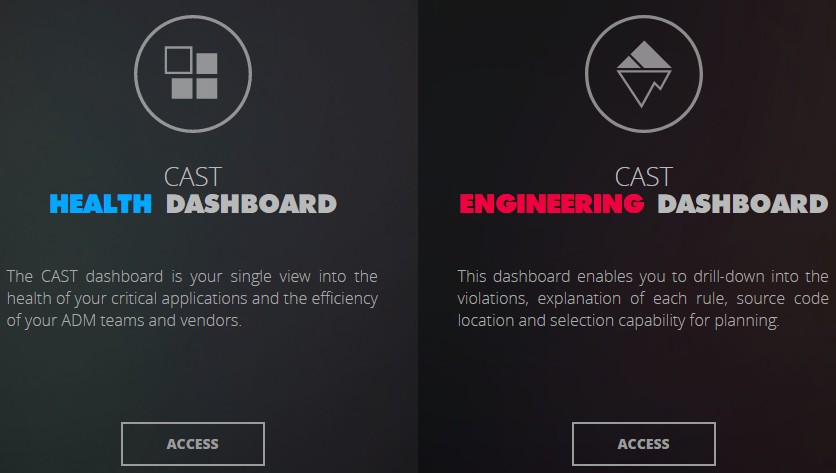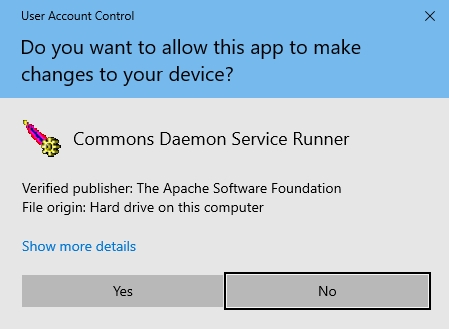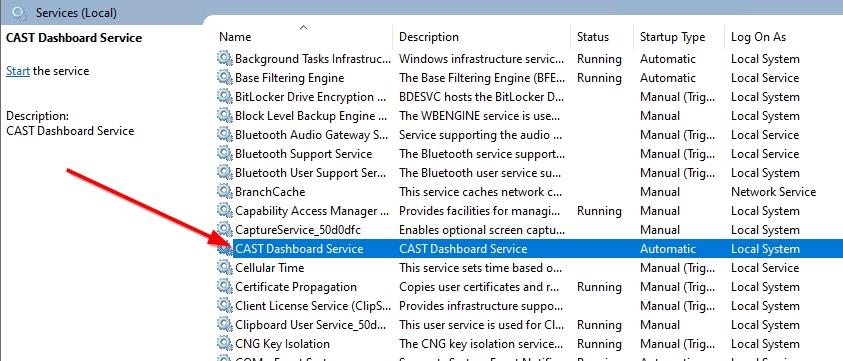Created by N Padmavathi, last modified by James Hurrell on Dec 06, 2021
Introduction
From release 2.0 onwards, CAST will deliver a ZIP file for each CAST Dashboard, alongside the traditional WAR file that has always been delivered. The ZIP file is a new method of deploying the CAST Dashboards based on Spring Boot and does not require a web application server (the application server is embedded in the ZIP itself). The aim of the ZIP file releases is to simplify and speed up the deployment of the CAST Dashboards. The deployment and configuration of the Spring Boot based dashboards differs slightly to the steps required for traditional WAR files (see Standalone Engineering Dashboard deployment using WAR file).
How many Engineering Dashboards do I need?
CAST highly recommends that you install one Engineering Dashboard and consolidate all your CAST Dashboard Services schemas into this.
Standalone or combined ZIP file?
Click here to expand...
CAST provides the Engineering Dashboard in two ZIP files as follows:
ZIP file name | Description |
|---|
| com.castsoftware.aip.dashboard.engineering.<version>.zip | Traditional "standalone" ZIP file containing only the Engineering Dashboard. This document describes the installation using this ZIP file. |
| com.castsoftware.aip.dashboard.<version>.zip | "Combined" ZIP file containing both the Engineering Dashboard and the Health Dashboard. |
You are free to use whichever ZIP file you prefer to deploy the Engineering Dashboard (the requirements and prerequisites are identical), however if you are using both the Health Dashboard and Engineering Dashboard, to fulfil (for example) a "risk and quality" use case, then it would make sense to take advantage of the combined com.castsoftware.aip.dashboard.<version>.zip file and deploy both dashboards from the same ZIP file. If you do so, please note the following about using the "combined" ZIP file:
- There is no need to specifically configure a URL for your Engineering Dashboard drilldown (via the "microscope" icon) from the Health Dashboard - when using the combined "ZIP" file, access to the Engineering Dashboard from the Health Dashboard is pre-configured.
- Security access and authentication is common to both Dashboards. Therefore, if you setup Active Directory authentication, then this must be used to access both Dashboards - you cannot use "Default Authentication" for one Dashboard and "Active Directory" for the other.
- Role configuration is common to both Dashboards. Therefore "UserA" that has been granted the "admin" role, will have the "admin" role in both Dashboards.
- Data authorization is common to both Dashboards. Therefore if you authorize "UserA" to view Application "B" only via the authorizations.xml file, then this is true for both Dashboards. Note that authorizations based only on Tags and Categories created for the Health Dashboard (Tags and Categories are a feature that is not available in the Engineering Dashboard) WILL be applied in the Engineering Dashboard when using the combined war file.
- Group configuration is common to both Dashboards, regardless of the authentication mode in use. Therefore if you authorize "GroupD" to view Application "E" only, then this is true for both Dashboards.
- On login, the user will be presented with a choice of Dashboard as shown below (Image 1) in a "Welcome" page. Clicking Access will take the user to the custom login screen for the chosen Dashboard where a "Return to welcome page" URL is available if the user wishes to login to the other Dashboard (Image 2):
Image 1 - Welcome page

Image 2 - Return to welcome page URL

Requirements
See Standalone dashboard - installation requirements.
Pre-installation check list
Before beginning the installation process, please ensure that you have carried out all of the following tasks and that the following requirements have been met:

| Ensure you have read all Release Notes accompanying CAST products for any last-minute information. |

| Decide where the Engineering Dashboard will be installed and run from. |

| Ensure that your user login on the target machine has sufficient user privileges to install applications. |

| Make sure you have the required .ZIP file ready for deployment. |
Installation procedure
The installation process is divided into various steps:
| Step 1 | Unpack the ZIP file |
|---|
| Step 2 | Configure the connection parameters |
|---|
| Step 3 | Install the license key |
|---|
| Step 4 | Install the Microsoft Windows Service to start/top the application server - optional |
|---|
| Step 5 | Start the dashboard and test connection |
|---|
| Step 6 | Configure user authentication |
|---|
| Step 7 | First login and become admin - ≥ 2.1 only |
|---|
| Step 8 | Configure roles |
|---|
| Step 9 | Generate snapshot data for display |
|---|
| Step 10 | Configure data authorization |
|---|
Step 1 - Unpack the ZIP file
Unpack the ZIP file on the server. You can run the dashboard directly from wherever you unpack the ZIP file, however, you may want to move the unpacked files to a more appropriate location.
Modify application.properties to define connection to CSS/PostgreSQL for AIP schemas
Click here to expand...
When the ZIP has been unpacked you now need to configure the application.properties file to tell the web application on which CAST Storage Service/PostgreSQL instance the Dashboard schemas are stored. This file is located here:
<unpacked_zip>\configurations\application.properties
Locate the following section in the file:
## DATASOURCE
# Resource1 is the datasource name used in domains.properties
# Adapt server name (localhost) and port (2282) if required
# You can add multiple datasources if you want to connect to multiple CSS Servers. Datasource name must be unique
# You have to configure your domains names and relative schema names in domains.properties
restapi.datasource[0].url=jdbc:postgresql://localhost:2282/postgres
restapi.datasource[0].username=operator
restapi.datasource[0].password=CastAIP
restapi.datasource[0].poolname=Resource1
restapi.datasource[0].minimumIdle=10
restapi.datasource[0].maximumPoolSize=20
If all your Dashboard schemas are located on one single CAST Storage Service/PostgreSQL instance then you need to modify the url, username and password entries to match your target CAST Storage Service/PostgreSQL, for example:
## DATASOURCE
# Resource1 is the datasource name used in domains.properties
# Adapt server name (localhost) and port (2282) if required
# You can add multiple datasources if you want to connect to multiple CSS Servers. Datasource name must be unique
# You have to configure your domains names and relative schema names in domains.properties
restapi.datasource[0].url=jdbc:postgresql://192.168.200.104:2282/postgres
restapi.datasource[0].username=operator
restapi.datasource[0].password=CastAIP
restapi.datasource[0].poolname=Resource1
restapi.datasource[0].minimumIdle=10
restapi.datasource[0].maximumPoolSize=20
If your Dashboard schemas are located on multiple CAST Storage Services/PostgreSQL instances, you need to add in the additional servers as shown in the example below:
- Ensure that you modify the
url, username, password and resource entries to match your target CAST Storage Service/PostgreSQL. In particular, the resource entry must be unique within the application.properties file. - The
[0] must also be incremented for additional CAST Storage Service/PostgreSQL instances, for example, use restapi.datasource[1], restapi.datasource[2] etc.
## DATASOURCE
# Resource1 is the datasource name used in domains.properties
# Adapt server name (localhost) and port (2282) if required
# You can add multiple datasources if you want to connect to multiple CSS Servers. Datasource name must be unique
# You have to configure your domains names and relative schema names in domains.properties
restapi.datasource[0].url=jdbc:postgresql://192.168.200.104:2282/postgres
restapi.datasource[0].username=operator
restapi.datasource[0].password=CastAIP
restapi.datasource[0].poolname=Resource1
restapi.datasource[0].minimumIdle=10
restapi.datasource[0].maximumPoolSize=20
restapi.datasource[1].url=jdbc:postgresql://192.168.200.105:2282/postgres
restapi.datasource[1].username=operator
restapi.datasource[1].password=CastAIP
restapi.datasource[1].poolname=Resource2
restapi.datasource[1].minimumIdle=10
restapi.datasource[1].maximumPoolSize=20
Save the file before proceeding.
Modify domains.properties
Click here to expand...
You now need to configure the domains.properties file which provides a link between the CAST Storage Services/PostgreSQL instances defined in the application.properties file and the Dashboard schemas containing the relevant snapshot data. This file is located here:
<unpacked_zip>\configurations\domains.properties
This file is delivered empty as shown below:
# Domains for ED
# empty lines in this file lead to connection error, remove all empty lines
# - You have to align [Resource1] with the resource name configured in application.properties
# - You have to replace [Central Schema1] by the central schema name
# - Domains names must be unique
# AED1=Resource1,[Central Schema1]
# AED2=Resource1,[Central Schema2]
For each Dashboard schema that you need to display in the CAST Engineering Dashboard, add one line to the file ensuring that there are no empty lines:
| AED1 | This is known as the "domain" and this must be unique in the domains.properties file. Therefore for each Dashboard schema you need to display in the CAST Engineering Dashboard, you need to assign one unique domain. You can use any domain name notation you want, however, CAST highly recommends incrementing the number, i.e. AED1, AED2, AED3 etc. |
|---|
| Resource1 | This entry refers to the CAST Storage Service/PostgreSQL instance as defined in the application.properties file. |
|---|
| [Central Schema1] | This entry refers to the Dashboard schema containing the relevant Application data. |
|---|
For example, for one single Dashboard schema called "MEUDON_CENTRAL" stored in the CAST Storage Service/PostgreSQL instance defined in Resource1 in the application.properties file, add the following:
# Domains for ED
# empty lines in this file lead to connection error, remove all empty lines
# - You have to align [Resource1] with the resource name configured in application.properties
# - You have to replace [Central Schema1] by the central schema name
# - Domains names must be unique
# AED1=Resource1,[Central Schema1]
# AED2=Resource1,[Central Schema2]
AED1=Resource1,MEUDON_CENTRAL
For multiple Dashboard schemas where all schemas are located in the same CAST Storage Service/PostgreSQL instance defined in Resource1 in the application.properties, add the following:
# Domains for ED
# empty lines in this file lead to connection error, remove all empty lines
# - You have to align [Resource1] with the resource name configured in application.properties
# - You have to replace [Central Schema1] by the central schema name
# - Domains names must be unique
# AED1=Resource1,[Central Schema1]
# AED2=Resource1,[Central Schema2]
AED1=Resource1,MEUDON_CENTRAL
AED2=Resource1,SEVRES_CENTRAL
AED3=Resource1,PARIS_CENTRAL
For multiple Dashboard schemas where the schemas are located on different CAST Storage Services/PostgreSQL instances (Resource1 and Resource2) as defined in the application.properties file, add the following:
# Domains for ED
# empty lines in this file lead to connection error, remove all empty lines
# - You have to align [Resource1] with the resource name configured in application.properties
# - You have to replace [Central Schema1] by the central schema name
# - Domains names must be unique
# AED1=Resource1,[Central Schema1]
# AED2=Resource1,[Central Schema2]
AED1=Resource1,MEUDON_CENTRAL
AED2=Resource2,SEVRES_CENTRAL
AED3=Resource2,PARIS_CENTRAL
Save the file before proceeding.
Modify application.properties to define connection to CSS/PostgreSQL for the roles/permissions schema - ≥ 2.1 only
Click here to expand...
In ≥ 2.1 only, an interface exists to manage User roles - 2.x and above and Data authorization - 2.x and above - this interface stores all its records in a dedicated schema on a CAST Storage Service/PostgreSQL instance. This instance does not need to be the same as used for your AIP schemas (Dashboard/Measure schemas), however, the required schema is small and therefore CAST recommends using an existing CAST Storage Service/PostgreSQL instance to host it. The schema is created automatically when you start up your Dashboard deployment if it does not already exist.
The application.properties file contains a section dedicated to this schema - this file is located here:
<unpacked_zip>\configurations\application.properties
Locate the following section in the file:
#datasource configuration for user management
spring.datasource.url=jdbc:postgresql://localhost:2282/postgres?ApplicationName=DASHBOARDS¤tSchema=cast_dashboards
spring.datasource.platform=postgres
spring.datasource.username=operator
spring.datasource.password=CastAIP
spring.datasource.initialization-mode=always
spring.datasource.driver-class-name=org.postgresql.Driver
spring.liquibase.change-log=classpath:db/changelog/db.changelog-master.xml
spring.liquibase.default-schema=cast_dashboards
spring.liquibase.enabled=true
Change the line spring.datasource.url to match the CAST Storage Service/PostgreSQL instance you intend to use for the roles/permissions schema, for example:
#datasource configuration for user management
spring.datasource.url=jdbc:postgresql://192.168.200.104:2282/postgres?ApplicationName=DASHBOARDS¤tSchema=cast_dashboards
spring.datasource.platform=postgres
spring.datasource.username=operator
spring.datasource.password=CastAIP
spring.datasource.initialization-mode=always
spring.datasource.driver-class-name=org.postgresql.Driver
spring.liquibase.change-log=classpath:db/changelog/db.changelog-master.xml
spring.liquibase.default-schema=cast_dashboards
spring.liquibase.enabled=true
Save the file before proceeding. This will ensure that a schema called "cast_dashboards" is created on the target CAST Storage Service/PostgreSQL instance when you start the web application.
Step 3 - Install the license key
As explained in Dashboard Service license key configuration, when you want to access a Dashboard schema using the CAST RestAPI (i.e. via the Engineering Dashboard, or via the CAST Report Generator), a special license key is required. This license key grants specific access to one or multiple Dashboard schemas for the web application in which it is installed (i.e. the Engineering Dashboard or the CAST RestAPI).
You must therefore install the license key and, if you are using a restricted license key, define data access authorization. These two steps are explained in Dashboard Service license key configuration in the sections How do I install a license key? and How to authorize users when using a RESTRICTED license key.
Step 4 - Install the Microsoft Windows Service to start/stop the application server - optional
Click here to expand...
If you have deployed the ZIP file on Microsoft Windows and would like to control the application server via a Microsoft Windows Service, CAST provides an installation batch script to do this for you. Locate the following file:
<unpacked_zip>\dashboard-service-install.bat
Double click this file to start the service installation. You may be prompted to accept a UAC warning:

On completion the service will be listed as CAST Dashboard Service with a startup type set to Automatic, log on as Local System and will not be running:

Step 5 - Start the dashboard and test connection
To start the dashboard:
- either start the Windows Service if you are using Microsoft Windows and have chosen to install the Windows Service
- or run the following file:
Microsoft Windows
<unpacked_zip>\startup.bat
Linux
<unpacked_zip>\startup.sh
Note that you may need to run "chmod +x startup.sh" to grant execution permission to the script before running it.
You may also need to run this file with elevated permissions (e.g. sudo) using the following syntax "./startup.sh"
By default the dashboard is configured to run on port 8080. Use the following URL - where <server_name> is equal to the host name of the current server to access the dashboard. If you are testing on the server itself, you can use http://localhost:8080:
http://<server_name>:8080
You should see the login page as follows - this indicates that the initial setup was successful:

This step involves configuring how your users will authenticate with the CAST Engineering Dashboard. Most organizations opt for LDAP/Active Directory integration so that users can use their corporate username/password to access the resources they need. The Engineering Dashboard also has a built in username/password authentication mechanism which is enabled "out of the box". See User authentication.
Step 7 - First login and become admin - ≥ 2.1 only
By default, the CAST Dashboard requires that at least one user is granted the ADMIN role following the first login after the User authentication configuration. This ensures that one user can access all data and cofiguration settings. See First login and become admin. This step is not required when using Dashboards 1.x and can be skipped.
This step involves configuring roles for users and groups that are accessing the CAST Engineering Dashboard. See User roles.
Step 9 - Generate snapshot data for display
Before your users can "consume" data via the CAST Engineering Dashboard, you need to generate snapshot data.
An Authorization defines permission to access and "consume the data" in a specific Application or group of Applications via the CAST Engineering Dashboard. If permission is not granted, or a "restriction" is used, then any information related to this Application will be not accessible: application properties such as name, technologies or grades and measures, etc. Therefore, an Authorization must be defined before a user/group of users can access a specific application. See Data authorization.
Advanced configuration specific to the CAST Engineering Dashboard:
Additional advanced configuration options:







